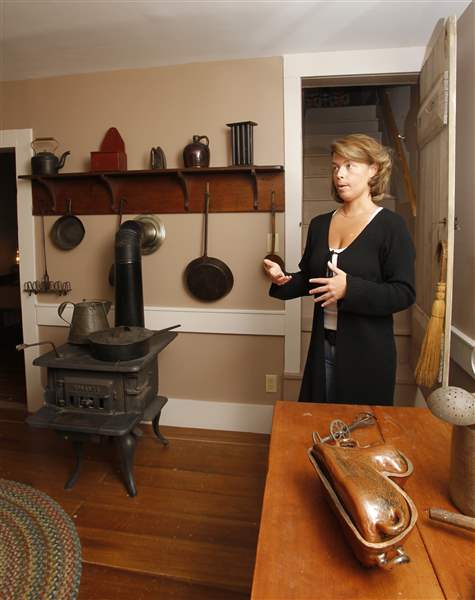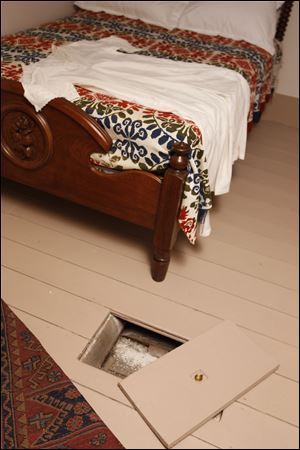
Hancock County museum adds 2 homes from 1840s
6/13/2011
Renee Smith, museum curator, leads a tour of one of its homes on Sandusky Street in Findlay, where the museum complex is growing again.
The Blade/Lori King
Buy This Image

Renee Smith, museum curator, leads a tour of one of its homes on Sandusky Street in Findlay, where the museum complex is growing again.
FINDLAY — At a time when some local history museums are struggling to keep their doors open, the Hancock Historical Museum just keeps growing.
It is nearly finished restoring the 1840s-era De-Wald Funk House, which it moved to its campus last summer, and is raising funds to restore the 1843 Davis Homestead, which also was moved to the museum’s Sandusky Street campus last summer.
The two historic homes — coupled with the museum’s 1840 log cabin and 1881 Victorian house — are expected to give visitors a peek into life through the years in Hancock County.
“It wasn’t our plan,” Executive Director Sue Tucker admitted. “It just happened, and I think it’s going to work out well for us.”
The Davis Homestead — a large two-story, wood-frame farmhouse believed to be one of the oldest homes in the county — was built on what is now U.S. 224 east of Findlay by William Davis, a man who museum curator Renee Smith said “did a little bit of everything.”
“He was a justice of the peace, a county commissioner, a trader, and one of the largest livestock owners in Hancock County,” Ms. Smith said.
Mr. Davis did his trading at the Blanchard River and marked out a path from his home to the river that today is Tiffin Avenue or U.S. 224 in Findlay.
Needless to say, when Blanchard Valley Health Systems offered the house to the museum at no cost last year, leaders couldn’t say no. Blanchard Valley said it would demolish the house unless it could be moved within six months.
“This fell into our laps, and we could not let that Davis house be torn down,” Ms. Smith said.
“So often museums and historical groups say, ‘We should, we should, we should.’ We did it, and we’re really proud of it,” Ms. Tucker added. “We had a lot of sleepless nights, but we did it.”
About the same time, the museum decided to move the De-Wald Funk House from East Street to its campus. The house, which Ms. Smith describes as a typical “in town” home for Findlay in the mid-1800s, had been deeded over to the historical museum in 2007 by the Historic Preservation Guild of Hancock County when it dissolved as a non-profit organization.
Ms. Smith said that with a staff of just two full-time employees — herself and Ms. Tucker — it was challenging to have tours and programming at multiple sites.

A secret hiding place for valuables in a bedroom of the De-Wald Funk House.
Ms. Smith said the museum received a $75,000 grant from the Ohio Cultural Facilities Commission, sold the East Street property where the De-Wald Funk House had been located, and turned to its loyal supporters to come up with some $325,000 to cover the house moving costs, pour foundations for the homes, put them back together, and restore the inside of the smaller De-Wald Funk House.
While the Davis Homestead has been painted on the outside and given a new roof, its interior has not been touched.
Ms. Tucker estimates the museum will need $125,000 to $130,000 to restore the Davis home.
Ms. Smith, who has taken countless elementary classes through the log house and the Victorian mansion, said it will be a pleasure to show visitors the other two houses where Findlay families — one rural and one city — might have lived after the log cabin days.
“Now when you take them from the log cabin to the Victorian house, the kids will say, ‘Did that family that had the cabin win the lottery?’” Ms. Smith said.
The De-Wald Funk House is a simple wood frame structure with a parlor, dining room, and kitchen downstairs, and a narrow wooden stairway leading to two simple bedrooms upstairs. Underneath a rug in the master bedroom is a small trap door that opens to a secret hiding place — a spot where the owner likely kept any valuables.
“That’s the high point for the kids. They eat that up,” Ms. Tucker said.
More than 44,000 people visited the museum or took part in museum programs off-site last year, including more than 10,000 school-age children.
More information about the Davis Homestead project is available at hancockhistoricalmuseum.org.
Contact Jennifer Feehan at: jfeehan@theblade.com or 419-724-6129.